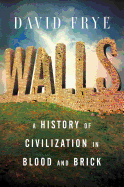
In 1987, Ronald Reagan stood before the Berlin Wall, a symbol of the Cold War, and told Mikhail Gorbachev to "tear down this wall." Two years later, Berliners took to the streets and began disassembling the wall, paving the way for the reunification of Germany and the collapse of Communism in Eastern Europe. Fast forward 30 years, Donald Trump speaks of the "big, beautiful wall" he wants built to separate the United States from Mexico ostensibly to curb illegal immigration, as similar structures also begin to emerge in Europe and elsewhere to turn away migrants.
In Walls, historian David Frye tells the story of civilization through man-made barriers. Spanning thousands of years of history, Frye considers the ancient world of "wallers and warriors." Defensive walls were built along the vast expanse of the Eurasian Steppe to keep Mongols and other barbarians at bay. In ancient Greece, Athenians built a wall around their city while Spartans eschewed them; the fortifications allowed mathematics, philosophy and the hallmarks of civilization to emerge in Athens, but also created a false sense of security, for the walls were penetrable. Frye travels through the "Great Age of Walls" when the Great Wall of China and Hadrian's Wall were built. The names of the barbarians changed, the building materials became stronger, but the story is often the same--walls were constructed to keep invaders out, while those behind them grew complacent and were unprepared when they were breached.
Tyrannical leaders and fearless aggressors have tussled throughout history, and countless men and women died building structures that were designed to protect them. Frye's history of the construction and subsequent destruction of walls is a colorful crash course in world history. --Frank Brasile, librarian

